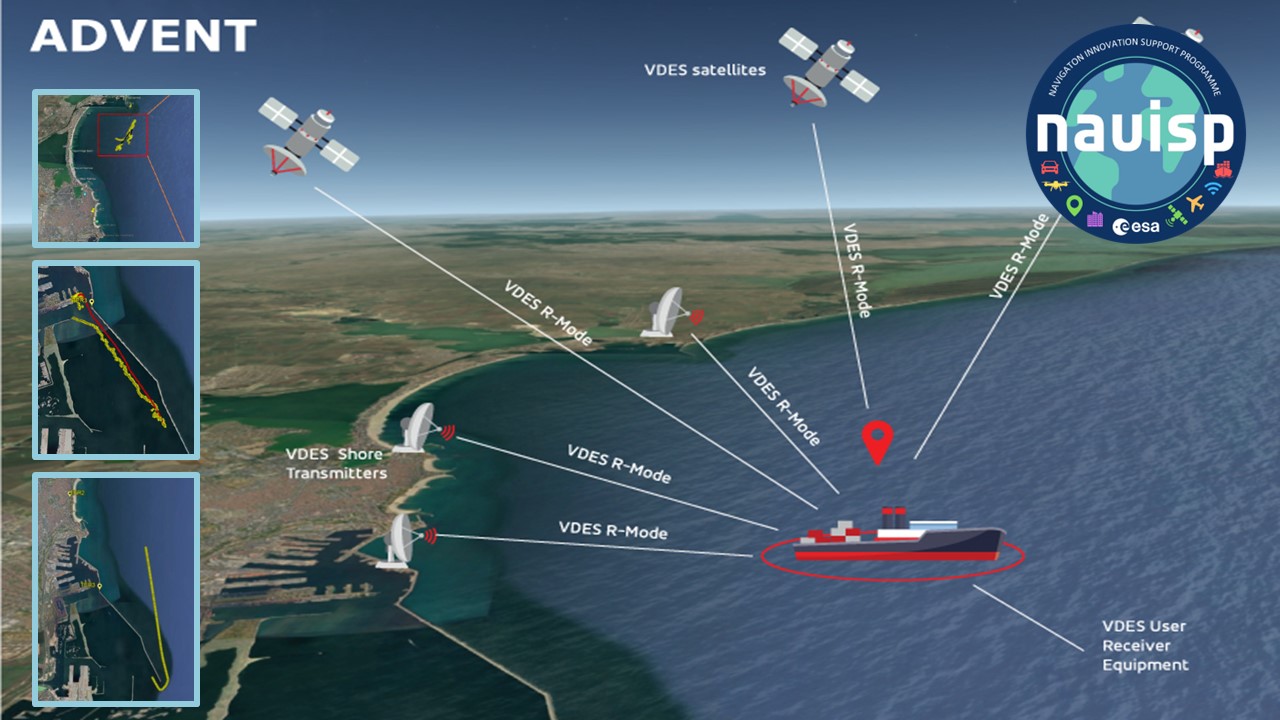Advanced VDES-R User Technologies for Alternative PNT
Last Updated: 04/06/2024 06:14 Created at: 04/06/2024 06:14

Final Presentation of NAVISP Project EL1-057 BIS now available:
On Thursday, May 30th, 2024, GMV NSL Ltd (UK) together with GMV Innovating Solutions S.R.L. (RO) and RHEATECH (UK) presented the results of the NAVISP EL1-057 BIS project "Advanced VDES-R User Technologies for Alternative PNT".
The maritime VHF Data Exchange System (VDES) is an emerging technology being explored as a potential alternative for Positioning, Navigation, and Timing (PNT) in the maritime domain. Traditional maritime navigation heavily relies on GNSS; however, VDES presents a promising complementary system with its ranging capability, known as VDES-R. This system could enhance maritime safety and navigation accuracy by providing an additional layer of PNT services. To fully understand and utilize the potential of VDES technologies in maritime navigation, extensive research and practical demonstrations are necessary.
In this context, the ADVENT project was initiated with the primary objective of investigating and validating novel user segment VDES technologies to bolster Complementary PNT capabilities for relevant maritime applications. Additionally, ADVENT focused on analysing the impact of critical system aspects such as synchronization and timing issues on VDES-R and evaluating alternative PNT solutions based on VDE-SAT in combination with VDE-TER services. Insights from the R-Mode Baltic, Orbcomm VHF satellite test, and the ICING project on NORSAT-TD provided valuable information for assessing PNT technique trade-offs and system design. Time-of-Arrival (TOA) and hybridization were identified as suitable PNT techniques, along with antenna diversity algorithms for increased availability.
During the project, key trade-offs in VDES-R system design were analyzed, encompassing modulation techniques, data sequences, channel capacity for R-mode, bandwidth and transmission duration, oscillators for time synchronization, and User Equipment (UE) power requirements. Additionally, programmatic trade-off criteria included cost, external constraints, implementation complexity, and hardware availability and technical trade-off criteria covered spectrum usage, multipath handling, signal resilience, scalability, accuracy, coverage, availability, and maturity. Based on this, the consortium successfully developed a VDES-R system simulator capable of generating VDES signals, including satellite signals. This simulator incorporates key aspects like timing, timeslot allocation, clock offsets, signal time of flight, and ionospheric delays, providing a robust platform for testing and development. Alongside the simulator, a proof of concept-testbed for terrestrial VDES-R was developed using Software Defined Radios (SDRs), enabling practical experimentation and validation.
A significant milestone of the project was a field trial conducted from 12th – 26th of October 2023 near the port of Constanta on the Black Sea. This trial involved deploying VDE-TER stations, transmitting VDES signals, and collecting data from both land and sea environments. The collected data, which included valid pseudoranges suitable for positioning, was used to assess the performance of the ADVENT testbed. The field trial demonstrated the system's dependence on good geometry and Carrier-to-Noise Ratio (CN0). For both terrestrial-only and augmented scenarios, the 2D solution achieved an overall accuracy of less than 50 meters (1 sigma). The terrestrial (TER) case utilized real trial data, while the TER+SAT case included additional satellite error modelling, accounting for factors such as ionospheric delays, orbit and clock errors, link fading, and ITU-R M.2092 link ID 33.
The results of the field trial provided valuable insights and led to recommendations for further enhancement of the ADVENT VDES-R prototype. Based on these findings, a comprehensive roadmap was developed outlining the enabling technologies required for the VDES system to support a future PVT service. This roadmap will guide future research and development efforts, ensuring that VDES can effectively complement existing maritime navigation systems and enhance overall maritime safety and efficiency.
The project was carried out in the scope of NAVISP Element 1, which is dedicated to technology innovation of the European industry in the wide PNT sector.
More detailed information can be found in the slides of the Final Presentation.
